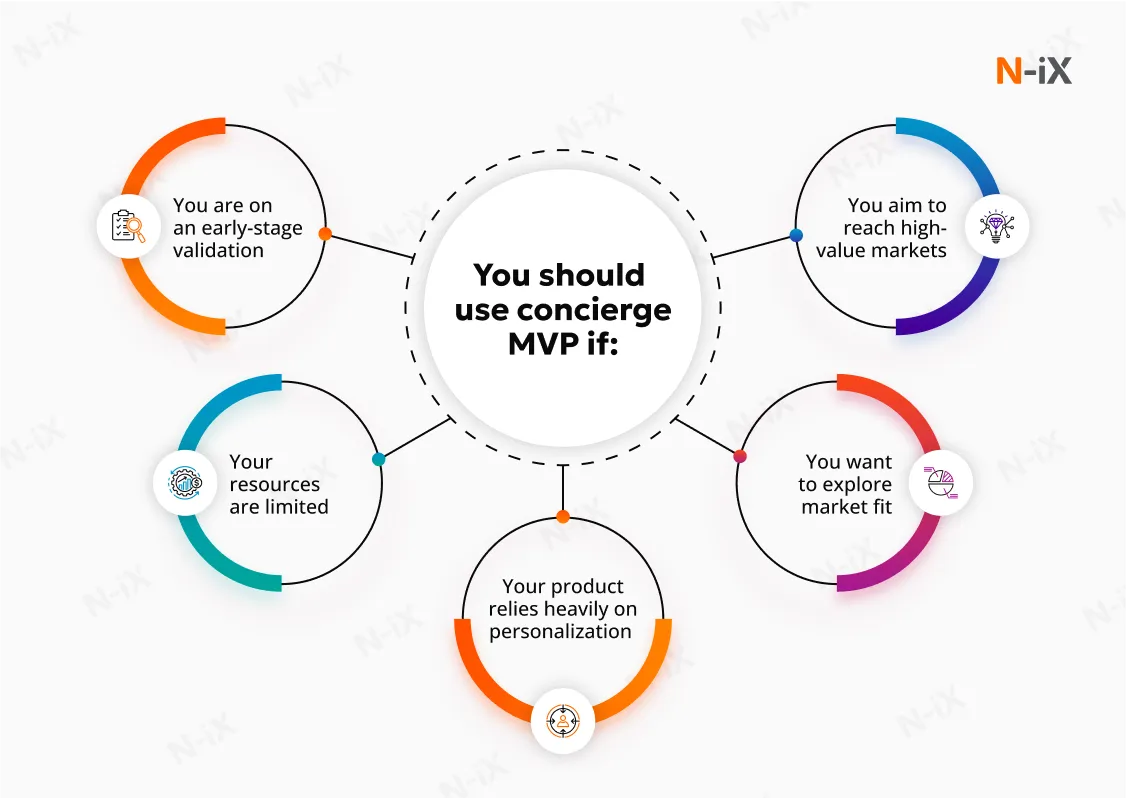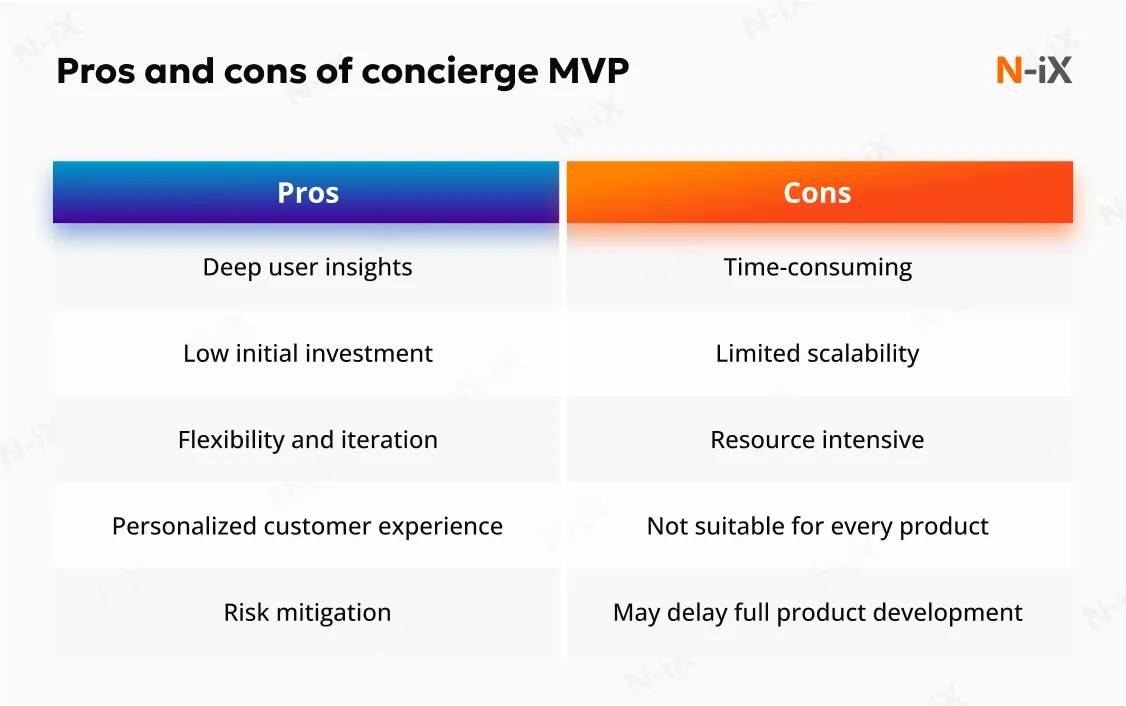Imagine launching your product with a highly curated experience, where every user is not just a tester, but a partner actively shaping your solution. This is the essence of a concierge MVP—a refined approach to the minimum viable product that focuses on delivering tailored, hands-on service to your initial users. Instead of simply testing assumptions, you’re engaging directly with early adopters, gaining invaluable insights into their needs, behaviors, and expectations in real-time.
Unlike a regular MVP development, which is often a stripped-down version of the product that relies on automation, a concierge MVP involves a manual, personalized delivery of your service. It’s a strategy that allows you to deeply understand your users before scaling, ensuring that your product is precisely aligned with market needs.
In this article, we break down the notion, concierge MVP examples, use cases, pros, cons, and more.
Concierge MVP: Definition
To better understand the concierge MVP definition, let’s compare it to a regular MVP. It has just enough functionality to test its core value proposition, often relying on automation to serve a broad audience quickly. So, the main priorities of a regular MVP are speed and idea validation with minimal resources.
Meanwhile, concierge MVP involves delivering the product or service manually, with a hands-on approach, offering a highly personalized experience to a small group of users. Picture it like launching your new product or service, but instead of creating a fancy website, you handle everything personally—like a dedicated concierge.
This method allows for direct feedback and deeper insights into user needs and behaviors, providing a more nuanced understanding of the market before scaling.
Read more about the top MVP development companies
Such an approach is often used when a company wants to test its business idea and gather critical data before investing heavily in building out the full product. By offering a "concierge" level of service, you manually deliver the solution and observe how users respond, what features they use, and where the pain points are. This feedback is then used to iterate and refine the product, ensuring that the final version is well-aligned with the market’s actual needs.
Let’s take a closer look at business cases when a concierge MVP is a good idea.
You should go for a concierge MVP if:
1. You are in the early stage of validation
When you're just starting your product journey and need to understand your target users' needs on a deeper level, a concierge MVP is the ideal approach. By manually delivering a personalized service to a select group of users, you can gather critical insights and test your assumptions before committing to a fully automated solution.
2. Your resources are limited
If your team is small or if you're looking to avoid significant upfront investment in building complex features, this approach allows you to test your core value proposition with minimal resources. You can manually manage the service while still gaining valuable feedback, all without scaling prematurely.
Learn more about MVP outsourcing
3. You want to explore market fit
When you're unsure about the right direction or features for your product, a concierge MVP offers flexibility. By engaging directly with users and iterating based on real-time feedback, you can refine your product and validate market fit before expanding and investing in automation or broader rollout.
4. Your product relies heavily on personalization
In such a business case, this MVP type offers the perfect opportunity to fine-tune customer experiences. By delivering tailored solutions manually, you can closely observe user behavior and preferences, ensuring that your final product meets their specific needs. Leveraging tools to speed up this process can help you test and adjust quickly.
One of the concierge MPV examples is an early-day Airbnb. Its founders manually handled all aspects of their platform. They personally took photos of the listed properties and ensured that guests had a smooth experience. This hands-on approach allowed them to gather critical feedback from both hosts and guests while refining the concept before building the platform we know now.
5. You aim to reach high-value markets
If you are targeting a niche market with a limited but highly valuable customer base, a concierge MVP allows you to build deep, meaningful relationships with your users. This personalized approach helps you truly understand their needs, enabling you to refine your offering before scaling.

However, when considering it for your product, it’s essential to weigh the benefits and challenges it brings. While this approach offers a more personalized and flexible route to market validation, it also comes with certain limitations that might affect the scalability and resource demands of your business. Here’s a closer look at the pros and cons of using it:
Pros of using a concierge MVP
Deep user insights
By offering a personalized, hands-on experience, such an MVP allows you to directly engage with early adopters. This real-time feedback is invaluable for understanding your users' needs, preferences, and pain points, ensuring that the final product aligns perfectly with the market.
Low initial investment
Since the process is manual and doesn’t require building out complex automation systems, it allows you to validate your idea with minimal resources. This approach saves you from making large upfront investments before you fully understand your product's potential.
Flexibility and iteration
The ability to quickly iterate based on user feedback is definitely a strong suit of this approach. Since you’re manually handling the service, adjustments can be made quickly, allowing for a more agile development process and ensuring that you’re on the right path before scaling.
Personalized customer experience
For businesses that focus on customization or high-touch services, it provides a unique opportunity to deliver a personalized experience. You can fine-tune how your product or service is delivered to individual users, ensuring their needs are met precisely.
Risk mitigation
By manually validating the core features with a small group of users, a concierge approach helps you avoid the risk of building an entire product that no one wants. You can test assumptions in a low-risk, controlled environment, saving both time and money in the long run.
Cons of using a concierge MVP
It is time-consuming
Since the concierge MVP involves manual intervention and tailored experiences for each user, it can be time-consuming. This model doesn’t scale easily, and handling multiple users manually can lead to bottlenecks, limiting how many users you can engage with at once.
It has limited scalability
While a concierge MVP is perfect for early-stage validation, it is not a scalable solution. As your customer base grows, it becomes increasingly difficult to maintain a high level of personalization without automation or additional resources, which could hinder growth.
It requires significant resources
Though the initial investment may be lower, such an approach still requires significant time and effort from your team. Manually managing a product or service, engaging with users, and iterating based on feedback can stretch limited resources, particularly if the team is small.
It’s not suitable for every product
It is ideal for services that rely on personalization or high-touch interactions, but it may not be the best fit for products that can be easily tested through automation or don’t require deep user engagement in the early stages.
It may delay full product development
While the concierge approach helps refine a product, the process of manually testing and iterating could delay the development of a fully automated or feature-complete product. This can lead to extended timelines before the product can scale and serve a larger audience.

FAQ
1. What is a concierge MVP?
It is a personalized, high-touch approach to product development, where a business manually delivers the product or service to a select group of users to validate the core concept. Instead of building a fully automated system right away, the focus is on engaging deeply with users, gathering feedback, and refining the product based on real-world insights.
2. How do I transition from MVP to a scalable product?
Once you’ve validated your core concept, the next step is to automate processes, refine features, and build out the full system. Transitioning involves using the insights gained during the manual phase to focus on building a product that can handle larger user volumes while maintaining the key elements that made the personalized approach successful.
3. Is a concierge MVP right for my business?
If your product requires deep user engagement, personalization, or testing a complex idea with limited resources, such MVP could be a great fit. It’s especially valuable when you’re unsure about the direction of your product and need flexibility before investing heavily in full-scale development. However, it may not be suitable if you need to scale quickly or if automation is critical from the start.
4. Can a concierge MVP be applied to any industry?
Yes, it can be applied across various industries, particularly those where personalization, user experience, or service-based offerings are key. This includes sectors like SaaS, ecommerce, healthcare, education, luxury services, and B2B products. It’s most effective when testing new concepts in a controlled, high-touch environment before expanding.
Have a question?
Speak to an expert



